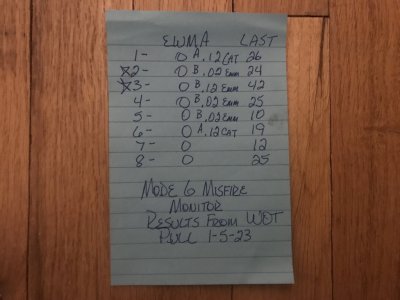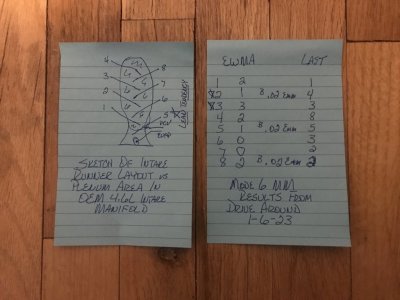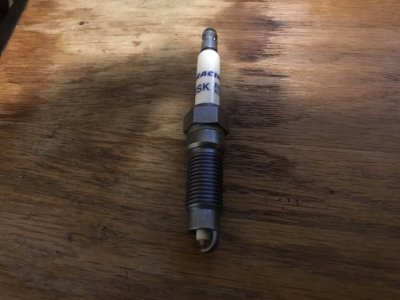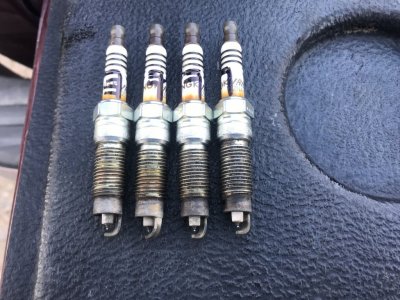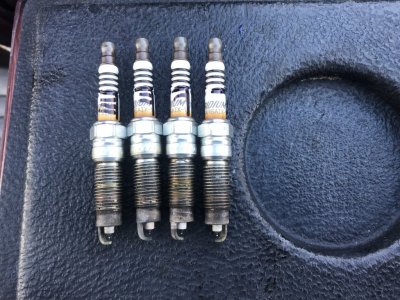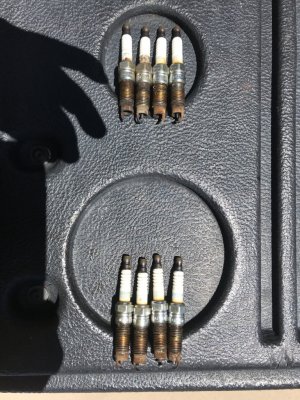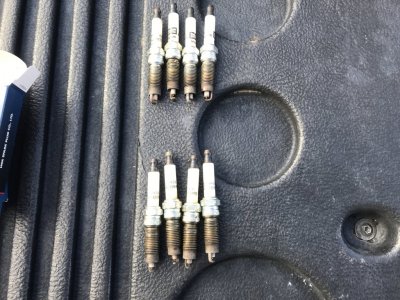GlassTop09
Senior Member
FYI............................
Got all my exhaust hanger parts in as well as a new trans isolator (Anchor brand off Rock Auto) since in process of installing all this I would be removing the trans crossmember & would be exposing it.
Got car up in the air & got under her to start pulling her apart......upon closer inspection I saw that the existing exhaust hanger rubber inserts actually were not busted up at all & were in good condition, so I left them in service & proceeded to replace the trans isolator. Pulled the old original 14 yr old FoMoCo isolator & checked it.......rubber wasn't cracked\separating but it was very soft (could easily deform it between my fingers whereas the new Anchor unit was much stiffer durometer rubber.......couldn't hardly get it to deform using my fingers as I did w\ the old FoMoCo unit) so I got ahead of this eventually cracking\breaking. Got all reinstalled & TQ'd to specs then got out a pry bar & pried B1 exhaust hanger as far down as it would go (noted it was bent upward & close to hitting the crossmember........) to match the B2 hanger position. Have also ordered 2 new Anchor OE type motor mounts off Rock Auto after this to replace them as well in better weather.
So, from this finding, I know now that the small saw-toothed knock pull data is legit so I went in revision #47 tune file & cut base MBT & base BKT spark advance timing across .40 thru 1.0 load rows .5* so both BKT & MBT spark map data maintained the 4.5* spacing & in all BKT\MBT VCT spark advance adder maps cut the .60 load row .01* multi & .70 load row .02* multi & flashed revision in PCM & performed all initial startup, idle & DC driving datalogs.....pushed her to 6,055 RPM's during this DC to test.......datalog showed that I got rid of most of this but still some showed up, so I went in revision #48 tune file again & cut base MBT\BKT spark advance timing in .70 thru 1.0 load rows another 3* then vertically smoothed .50 thru .70 load rows to transition (cut 3.5* so far), flashed it in & performed all again......datalog showed that I almost got it all gone during the low RPM, high load test as well as during WOT hit to actual engine redline in 3rd gear.....all else good, so I went in revision #49 tune file & cut .70 thru 1.0 rows in both base MBT & BKT spark advance maps another 1.5* (total of 5*....this should cancel out the 4.5* KS spark advance PCM is applying so hopefully clear up all the spark timing pulled from KS activity so I can now start tweaking all BKT\MBT VCT spark advance adder multi's to fine tune WOT) then vertically smoothed .50 thru .70 load rows again for transition & gave her a little more fuel (.84\.86 Lambda @ 11.83 AFR\12.11 AFR) to help further cool the cyls to stop any more pulled spark timing from KS activity.
Was getting dark & raining hard so I shut down for the day & went over\thru latest datalog w\ a fine-tooth comb & made some small setting changes in revision #49 in all MBT\BKT VCT spark advance adder map multipliers @ .80 thru 1.0 load rows based off my airload VCT load map cam retard degree settings in anticipation based off numbers I ran from prior tuner's WOT numbers he got w\o using these VCT multipliers (put all 0's in the .80 thru 1.0 load rows) so my total WOT calc'd numbers w\ VCT multipliers would come out just under his (approx 1*-1.5* less) so hopefully all goes clean so I can then bring my WOT numbers up to match\exceed his then start slowly leaning out the fueling until I see knock or I reach Lambda .88\.90 (12.390 AFR\12.673 AFR), whichever shows up 1st.
Otherwise, all is good........car runs very well w\ excellent drivability manners\responsiveness thruout........the main advantage of street\remote tuning vs a dyno (dynos are better for power tuning\component performance\output comparisons as you can differentiate\measure between small differences in output). I got my "dyno graph" set up & working in VCM Scanner.......but it won't be near as accurate as a real dyno (can't zero it out due to the small IPC WTE's generated between ETC\SD\LWFM airload predictive calc's vs actual MAF airload calcs thus has a calc'd TQ margin of error that varies too much).
Getting closer to being done...................
Got all my exhaust hanger parts in as well as a new trans isolator (Anchor brand off Rock Auto) since in process of installing all this I would be removing the trans crossmember & would be exposing it.
Got car up in the air & got under her to start pulling her apart......upon closer inspection I saw that the existing exhaust hanger rubber inserts actually were not busted up at all & were in good condition, so I left them in service & proceeded to replace the trans isolator. Pulled the old original 14 yr old FoMoCo isolator & checked it.......rubber wasn't cracked\separating but it was very soft (could easily deform it between my fingers whereas the new Anchor unit was much stiffer durometer rubber.......couldn't hardly get it to deform using my fingers as I did w\ the old FoMoCo unit) so I got ahead of this eventually cracking\breaking. Got all reinstalled & TQ'd to specs then got out a pry bar & pried B1 exhaust hanger as far down as it would go (noted it was bent upward & close to hitting the crossmember........) to match the B2 hanger position. Have also ordered 2 new Anchor OE type motor mounts off Rock Auto after this to replace them as well in better weather.
So, from this finding, I know now that the small saw-toothed knock pull data is legit so I went in revision #47 tune file & cut base MBT & base BKT spark advance timing across .40 thru 1.0 load rows .5* so both BKT & MBT spark map data maintained the 4.5* spacing & in all BKT\MBT VCT spark advance adder maps cut the .60 load row .01* multi & .70 load row .02* multi & flashed revision in PCM & performed all initial startup, idle & DC driving datalogs.....pushed her to 6,055 RPM's during this DC to test.......datalog showed that I got rid of most of this but still some showed up, so I went in revision #48 tune file again & cut base MBT\BKT spark advance timing in .70 thru 1.0 load rows another 3* then vertically smoothed .50 thru .70 load rows to transition (cut 3.5* so far), flashed it in & performed all again......datalog showed that I almost got it all gone during the low RPM, high load test as well as during WOT hit to actual engine redline in 3rd gear.....all else good, so I went in revision #49 tune file & cut .70 thru 1.0 rows in both base MBT & BKT spark advance maps another 1.5* (total of 5*....this should cancel out the 4.5* KS spark advance PCM is applying so hopefully clear up all the spark timing pulled from KS activity so I can now start tweaking all BKT\MBT VCT spark advance adder multi's to fine tune WOT) then vertically smoothed .50 thru .70 load rows again for transition & gave her a little more fuel (.84\.86 Lambda @ 11.83 AFR\12.11 AFR) to help further cool the cyls to stop any more pulled spark timing from KS activity.
Was getting dark & raining hard so I shut down for the day & went over\thru latest datalog w\ a fine-tooth comb & made some small setting changes in revision #49 in all MBT\BKT VCT spark advance adder map multipliers @ .80 thru 1.0 load rows based off my airload VCT load map cam retard degree settings in anticipation based off numbers I ran from prior tuner's WOT numbers he got w\o using these VCT multipliers (put all 0's in the .80 thru 1.0 load rows) so my total WOT calc'd numbers w\ VCT multipliers would come out just under his (approx 1*-1.5* less) so hopefully all goes clean so I can then bring my WOT numbers up to match\exceed his then start slowly leaning out the fueling until I see knock or I reach Lambda .88\.90 (12.390 AFR\12.673 AFR), whichever shows up 1st.
Otherwise, all is good........car runs very well w\ excellent drivability manners\responsiveness thruout........the main advantage of street\remote tuning vs a dyno (dynos are better for power tuning\component performance\output comparisons as you can differentiate\measure between small differences in output). I got my "dyno graph" set up & working in VCM Scanner.......but it won't be near as accurate as a real dyno (can't zero it out due to the small IPC WTE's generated between ETC\SD\LWFM airload predictive calc's vs actual MAF airload calcs thus has a calc'd TQ margin of error that varies too much).
Getting closer to being done...................


